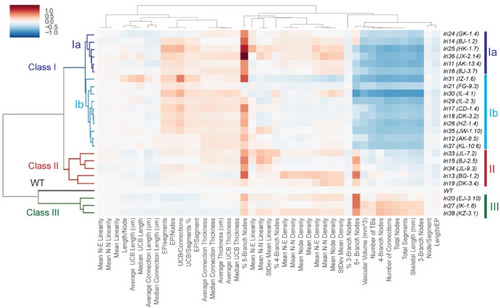Fig. 2
- ID
- ZDB-FIG-240620-10
- Publication
- Singh et al., 2024 - Forward genetics combined with unsupervised classifications identified zebrafish mutants affecting biliary system formation
- Other Figures
- All Figure Page
- Back to All Figure Page
|
Clustered heat map-based classification of recovered mutants. Clustered heat map based on the structural sub-parameters of the intrahepatic biliary network in recovered mutant larvae at 5 dpf. All sub-parameters are normalized to the average value of the corresponding sub-parameters in the wild-type dataset. Clustering was done with the hierarchical clustering algorithm. Red indicates a higher value than wild-type, and blue indicates a lower value than wild-type. Values represent the average for each specimen dataset. The x-axis of the dendrogram indicates the relative similarity of each structural sub-parameter to other sub-parameters. The shorter the line between two sub-parameters, the more closely related they are. Similarly, the y-axis indicates the relative similarity of each mutant phenotype to other mutant phenotypes. Classes are denoted by the color of the y-axis dendrogram: Wild-type (Black), Class Ia (Dark Blue), Class Ib (Light Blue), Class II (Red), and Class III (Green). Classification was unbiasedly based on network structural sub-parameters of the intrahepatic biliary network. |
Reprinted from Developmental Biology, 512, Singh, D.J., Tuscano, K.M., Ortega, A.L., Dimri, M., Tae, K., Lee, W., Muslim, M.A., Rivera Paz, I.M., Liu, J.L., Pierce, L.X., McClendon, A., Gibson, I., Livesay, J., Sakaguchi, T.F., Forward genetics combined with unsupervised classifications identified zebrafish mutants affecting biliary system formation, 44-56, Copyright (2024) with permission from Elsevier. Full text @ Dev. Biol.

